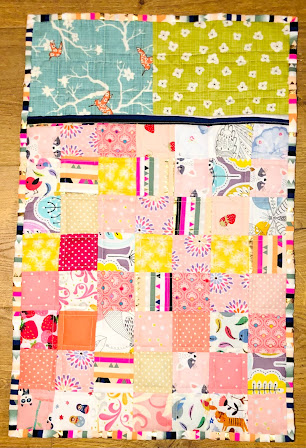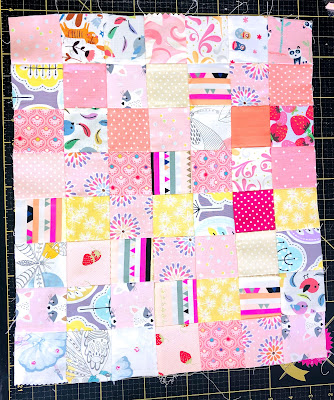Sunday, 6 February 2022
New Beginnings
Tuesday, 13 April 2021
FRAKTAL QUILT
A Customer Quilt
Pantograph:Apex 2 by Urban Elementz
Thread:
Glide 40wt Blueberry (top)
Decobob Antique White (bobbin)
Tuesday, 23 February 2021
SHOW YOUR STRIPES BLOG HOP
Stripy String Quilt
A little while ago Carla from Creatin in the Sticks put a call out to those of us that love stripes - any size any way, striped fabric, striped binding, strips of fabric to make stripes (here's where I come in) literally anything goes!
There are so many fantastic bloggers taking part over the week(schedule at the bottom) and a whole host of different projects, ideas and inspirations that you can read about and try out - I hope you will join in and show me your stripes!
If you have read by blog for a while or follow me on Instagram you will know how much I love scraps and using them for scrap quilts, you will also know how much I love Tula Pink and that every single tiny piece gets saved 'just in case' and that curating fabric pulls for quilts is one of my favourite things!! So when the opportunity came up to do all of this together plus add in my favourite technique of foundation paper piecing - I squealed out loud!!
Above is a quarter section of a String Quilt block measuring 7.5 inch square, this is what we will be making together using the Foundation Paper Piecing (FPP) method. FPP is a popular technique in patchwork for making quilts, done by sewing fabric to a printed paper foundation, although we will be doing something simple together the possibilities are endless and there are some absolutely amazing FPP patterns available.
There are many free templates available, but for ease you can download the template I made here if you want to make your own in a different size it's super easy - decide on the size of your block and draw it out, add 1/4 inch seam allowance all the way around and then draw in your sections.
** Please note you will need FOUR of these to make ONE whole block **
Step 1 Preparation
Decide on your fabrics and cut your strips. I cut mine 1.5 inches wide but you can have skinny stripes, fatter stripes or a mix of all of them. The length will vary depending on which stripe you're sewing so my advice is make sure they are at least as long as the longest section on the template and then trim accordingly after sewing!
You will be tearing the paper out at the end which can cause stress on your seams, for this reason I usually reduce my stitch length and make it shorter, either to 1.8 or 2 - it's not essential just personal preference.
You my also find it helpful to trim down the template (whichever you are using) to slightly bigger than the seam allowance, as it can be a bit of a fiddle trying to manoeuvre the paper and fabric at times.
Step 2 Sewing the first stripe
For these blocks I always start in the middle with the longest stripe and then sew everything on one side i.e. the left and then everything on the other side. As these templates aren't specifically numbered there is not 'right' way to do it, it's simply personal preference.
Starting with the longest section down the middle, place your chosen fabric stripe right side (patterned side) up over the whole section, it should extend 1/4 inch over the lines as this is creating seam allowance. Place your second fabric stripe directly on top of it right side down. You can put a pin in it to keep it secure if you wish, then flip it over so the fabric is underneath and your paper template is on top.
Sew directly on that line from one end to the other and then finger press your fabric open.
Step 3 Complete the block
Place your next piece of fabric right side down, lining up the edge with stripe 2, on top of the template as shown below. Flip and stitch down the line as before.
Continue in this way until all stripes have been sewn, you will end up with something that looks quite odd due to the excess fabric.
Step 4 Trimming the quarter blocks
With the paper template side up, trim down your block to the seam allowance line - DO NOT cut off the seam allowance!
I find it easiest to use the 1/4 inch line on my ruler and match this up with the lines around my template and block as shown below.
Trim off all the excess fabric on all sides until your block is square - if you're using my template it should measure 7.5 inches square.
Step 5 Trimming the quarter blocks
When all four quarters are pieced and trimmed, they can start to be assembled to make full blocks and this is where the fun begins!
Depending on where you have placed your fabrics and how you lay the sections/blocks out will change the over all look of the quilt.
Below are a few of these options.
You will start to see secondary patterns emerging when you lay multiple blocks out together, these can be highlighted with a bit more careful planning, depending on your fabrics choices.
I really hope you've enjoyed sewing along with me, if you make a block or 4 or more please let me know and share them with me, I love to see your creations.
You can see all the other bloggers in this fantastic blog hop below
Monday, February 22nd
Tuesday, February 23rd
Wednesday, February 24th
Thursday, February 25th

































